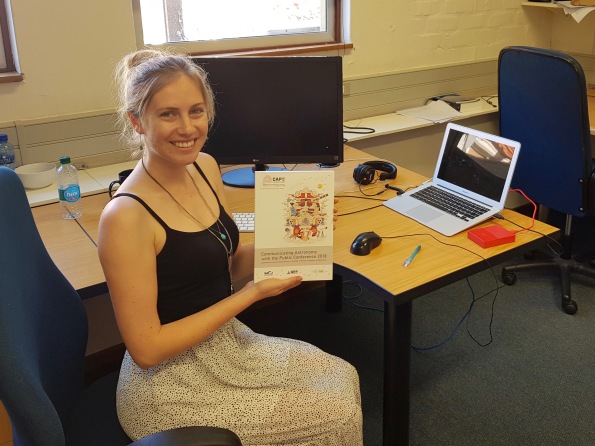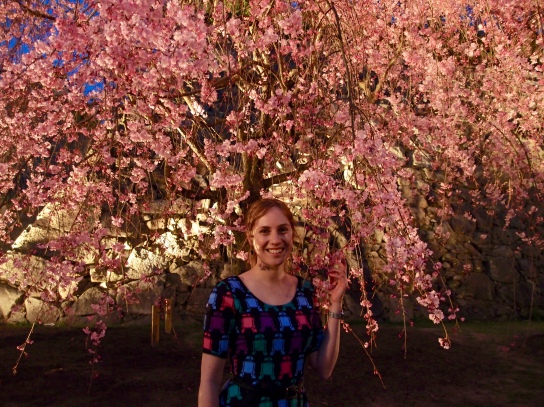This month, the International Astronomical Union has published the Communicating Astronomy with the Public 2018 (CAP2018) conference proceedings. It’s a hefty 428-page tome packed with valuable insights into topics highly relevant to our modern world.
While very few people in their right mind would tackle such a large volume(!), it does contain many really important messages which I feel should be shared with, and made accessible to, as large an audience as possible. Not just other astronomers and communicators, but also the wider public.
So this is the first of a series of posts I hope to write summarising (what I feel are) the key themes and messages of the CAP2018 conference and proceedings. These are:
- Why is astronomy communication important for the world?
- What are the barriers and best practices of astronomy communication?
- How do you make effective use of social media and use it to build a brand?
- How do you fight fake news, pseudoscience and misinformation?
- How do we work towards diversity & inclusivity in astronomy communication?
- What’s the big deal about 2019?
This post will tackle the first point – why is it important to communicate astronomy and what impact can this have on the world?

What is CAP2018?
First, a tiny bit of background on CAP2018. This year’s Communicating Astronomy with the Public (CAP) meeting was the world’s biggest ever astronomy communication conference! I had the great fortune of attending this fantastic event, which was held in the Japanese city of Fukuoka. It took place in March, amid the peak of the stunning cherry blossom season (also known as ‘sakura’ in Japan).

CAP2018 was run by the International Astronomical Union (IAU), which is a large world-wide body of professional astronomers. You know it – it’s the one that famously demoted poor little Pluto!
The IAU’s CAP conferences are held every two years and are big, awesome, international meetings focusing on the ‘why’ and ‘how ‘ of world-wide astronomy education, public outreach and communication.
The 2018 meeting had a record number of attendees. There were 446 people from 53 countries and every continent of the world (except Antarctica)! There were astronomers, science communicators, journalists, public representatives, and more. This exciting and encouraging variety certainly made for many lively discussions!

Why is astronomy communication important?
We all came from around the world to talk about astronomy communication at CAP2018. But why should we bother communicating astronomy at all? Is it even important? Does it have any impact on the world?
While I’ve long believed that astronomy communication is incredibly important, I admit it was based on more of a ‘gut feeling’ than anything particularly well thought-out. However, several of the CAP2018 presentations helped me to ratify the many excellent reasons for this.
The demand
The first reason is very simple. We should communicate astronomy with the public because people want to know. Just like dinosaurs, astronomy is a widely popular topic which easily captures the imagination. Almost everyone is at least a little bit curious, if not totally fascinated, by the mysteries of space and the universe. And rightly so – it’s incredible!
After spending the better part of ten years studying the subject, I can confirm that astronomy is indeed awesome. Out there in the ever-expanding vastness of space are whirling galaxies, exploding stars, gas-gorging black holes, mysterious dark matter and many other bizarre and amazing things. So cool!
(Um also, astronomy is the only muggle subject studied at Hogwarts…so it must be special!) 😛

Part of the popularity of astronomy is due to the fact that it is accessible. Unlike many other (equally awesome) branches of STEM (such as quantum physics or neuroscience), the basic principles of astronomy are not particularly abstract and form an observable, tangible part of a person’s life.
The night sky is directly above us all. Anyone can look up at it, marvel at the stars, be struck by awe and feel a curiosity to know what it’s all about. Many people will also experience fairly dramatic astronomical events at some point in their lives. Take, for instance, a total solar eclipse where the moon moves in front of the sun and literally turns day into night. It’s a little difficult not to notice!
It’s through events like these that the true extent of public interest in, and demand for, astronomy knowledge becomes apparent. For example, as Rick Feinberg of the American Astronomical Society reported at CAP2018, an incredible 20 million people left their homes and flocked towards the path of totality to watch the 2017 “Great American Solar Eclipse”. In total, an estimated 215 million American adults watched the eclipse in some way, according to a study from the University of Michigan. That’s 88% of the American adult population! Impressive.

The hook
Since astronomy is both popular and accessible, it is therefore an excellent ‘hook’. Herein lies what, I believe, is one of the most compelling reasons to provide excellent astronomy communication.
Interest in astronomy is a powerful platform from which to nurture a general interest in science, to increase scientific literacy, to stimulate critical thinking and to instil an appreciation for the scientific method.
It is thoroughly essential to embrace anything which will encourage these things in communities world-wide.
As Alessia Luca from Florence University said during her CAP2018 presentation, “Astronomy is one of the most accessible sciences, so it is a powerful tool for contributing to a better world”.

A better world
If we communicate astronomy, and we do it well, can this actually lead to any meaningful change in the world?
As I was delighted to discover at CAP2018, one excellent example of an organisation which attempts to facilitate such a change is the IAU’s Office of Astronomy for Development (astro4dev for short). The motto of astro4dev is “Astronomy for a better world.” They promote the use of astronomy as a vehicle to assist with sustainable socio-economic development.
During his CAP2018 presentation, Ramasamy Venugopal from astro4dev explained that, “Astronomy is not better than any other science, but it is multidisciplinary and deeply connected with many other aspects of life…We can leverage this to bring about global change.”
He also showed examples of how public engagement with astronomy can be used as a tool to work towards several of the United Nation’s 17 Sustainable Development Goals (SDG).

Astro4dev has provided seed funding for 122 astronomy-for-development based initiatives since 2013, as Vanessa McBride and co-authors explain in the CAP2018 proceedings and in their Nature Astronomy article.
For example, one project tackled poor literacy levels of middle school students in Sierra Leone by introducing an astronomy focus into lesson plans for subjects like science, mathematics and social science.
“The introduction of astronomy themes brought about a noticeable improvement in students’ literacy levels, because students were eager to learn and read about the topics at hand,” said Vanessa McBride (Nature Astronomy 2, 511–514, 2018).
Other projects aim to bridge economic and social gaps and reach out to marginalised groups by nurturing the historical and cultural aspects of astronomy. For instance, a project in Zambia is creating material to acknowledge and celebrate local indigenous astronomy knowledge with a view to reducing inequality by considering cultural contexts.
There are also initiatives to foster cross-disciplinary communication and collaboration to apply astronomy-gained expertise to other real-world problems. For example, techniques and technology developed for astronomy have been employed to tackle issues as varied as wildlife tracking and conservation, food security and the diagnosis of retinal problems.

One sky
Another important reason why public engagement in astronomy can be a powerful vehicle to improve the world is the simple fact that we are all literally under one sky.
It is something which connects us, a common experience we all share. Therefore, it is one of those rare things that can be used to foster a sense of global unity.
Astronomers Without Borders is an example of an organisation which uses this concept to make a difference to underserved communities world wide. Their philosophy is “One people, One sky.”
Mike Simmons, president of Astronomers Without Borders, presented one of their flagship projects at CAP2018. They are collecting used eclipse glasses to be redistributed to developing countries in South America and Asia. This way, many more people will have an opportunity to safely view the upcoming 2019 solar eclipse across those continents at no cost.
The response to this project from the USA was apparently quite overwhelming after the 2017 ‘Great American Eclipse.’ Collection centres for eclipse glasses spontaneously popped up everywhere. Many people commented that they were donating their glasses so that other people in the world could have the same “life-changing” experience that they had, thus displaying a sense of unity.

Since astronomy is truly universal, it is a “good friend to enhance peaceful relations between countries,” said Kazunari Shibata, president of the Astronomical Society of Japan, at CAP2018.
This sentiment was echoed by Setthawut Thongmee from the International Training Centre in Astronomy under the auspices of UNESCO (ITCA). He gave an excellent talk about the potential uses of astronomy in international diplomacy.
Setthawut said that “the world requires effective partnerships between scientists, policy makers and diplomats” and that astronomy is uniquely positioned to assist in this because it “cuts across national boundaries.”

Setthawut explained that science (including astronomy) and diplomacy are related in several different ways.
Firstly, science in diplomacy means that science can be used to advise foreign policy objectives. Perhaps an example of this would be climate science informing international policies on emissions. (If you know of an astronomy-related example, please let me know!)
Diplomacy for science is the concept of diplomacy facilitating international cooperation. For example, diplomacy for science is needed for different countries to work together to fund, build and run large telescope facilities like the upcoming Square Kilometre Array.
Science for diplomacy is the concept that scientific cooperation can improve international relations, and is where the ‘one sky’ argument comes in to play. For example, in working together on projects like the Square Kilometre Array – and specifically in communicating this work and its benefits – relationships between different nations can be nurtured and improved.

Why is astronomy communication important for astronomers?
Astronomy communication is not only important for the public and for the community on a global scale, but it can also be important for the field of astronomy itself and for the individual astronomer or science communicator.
Norio Kaifu, former Director General of the National Astronomical Observatory of Japan, said during his keynote CAP2018 address: “Many scientific ventures can’t be realised without the understanding & support of the general public.”
Elizabeth Tasker, from the Japan Aerospace Exploration Agency, agreed, saying: “Public support can make or break the future of a field!”

The reality is that scientific pursuits, such as astronomy, do require many resources and substantial commitment from communities, governments and nations. To put it quite bluntly, astronomy needs a lot of funding and it’s only going to get funded if the public think it’s worth it! So we should explain why it’s worth supporting.
Furthermore, “Astronomy is expensive, so we have an obligation to report what we’re doing with the money,” pointed out Gordon Squires, from Caltech/IPAC.
On the level of an individual astronomer/communicator, and in my own experience, I find that participating in astronomy outreach and communication is important because it helps me to stay engaged and interested in my own research and helps to put it all into perspective. I really have to understand the ‘big picture’ of my work before I can explain it to someone else. But the most significant and rewarding part of astronomy communication is, for me, the simple joy of sharing my passion with others.
In conclusion…
To conclude this deep dive, here is a summary of the reasons why astronomy communication is important. It is important because: it is sought after by the public, it is a gateway to improved scientific literacy and appreciation of science, it is necessary for continued public support of astronomy and science, it is beneficial to the astronomer or communicator, it can help to address sustainable socio-economic development, it is globally uniting and can be a vehicle for international generosity and diplomacy.
The CAP2018 conference proceedings provide a treasure trove of wonderful examples of how all these things are being put into practice right now. I’m grateful for the opportunity to have attended the conference and to share these thoughts with you now.
What are your thoughts? Why do you think it’s important to communicate astronomy? I’d love to hear your opinion so please feel free to leave a comment or get in touch!

Related links
- CAP2018 digital conference proceedings
- CAP2018 conference website
- The beautiful CAP2018 poster art
- International Astronomical Union
- IAU Office of Astronomy for Development
- Astronomers Without Borders
- Square Kilometre Array
Acknowledgements
Thank you so much to everyone involved in organising and hosting the CAP2018 conference and preparing the proceedings. In particular, the IAU’s Commission C2, the local, national and scientific organising committees, the event sponsors, the City of Fukuoka and the Fukuoka City Science Centre. Thanks to my fellow CAP2018 attendees. It was wonderful to meet so many enthusiastic, interesting, diverse and inspiring people. I acknowledge the University of Zagreb Faculty of Science (PMF) and Department of Physics for generous contributions towards the cost of my trip to CAP2018. Last but not least, thank you to you, for reading this post!

- Hanging out with the dinos at the Fukuoka City Science Museum – the CAP2018 venue and our hosts for the week. The museum opened in October 2017 and has already seen more than 600,000 visitors. I recommend a visit if you’re in the area!

1 comment